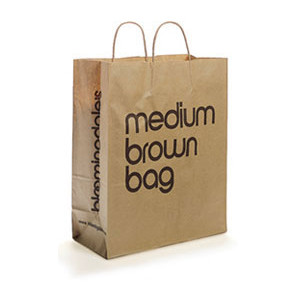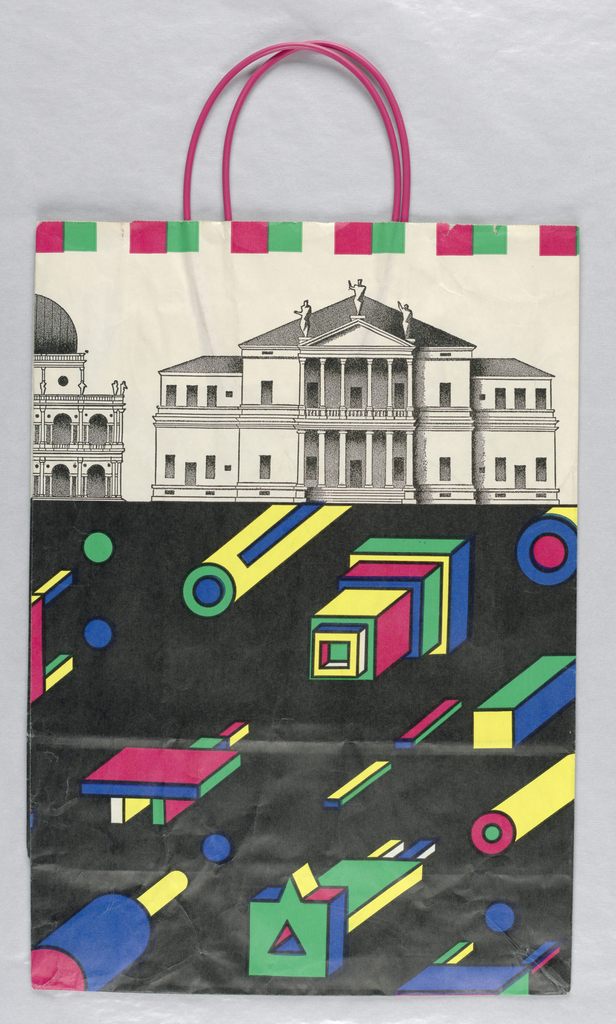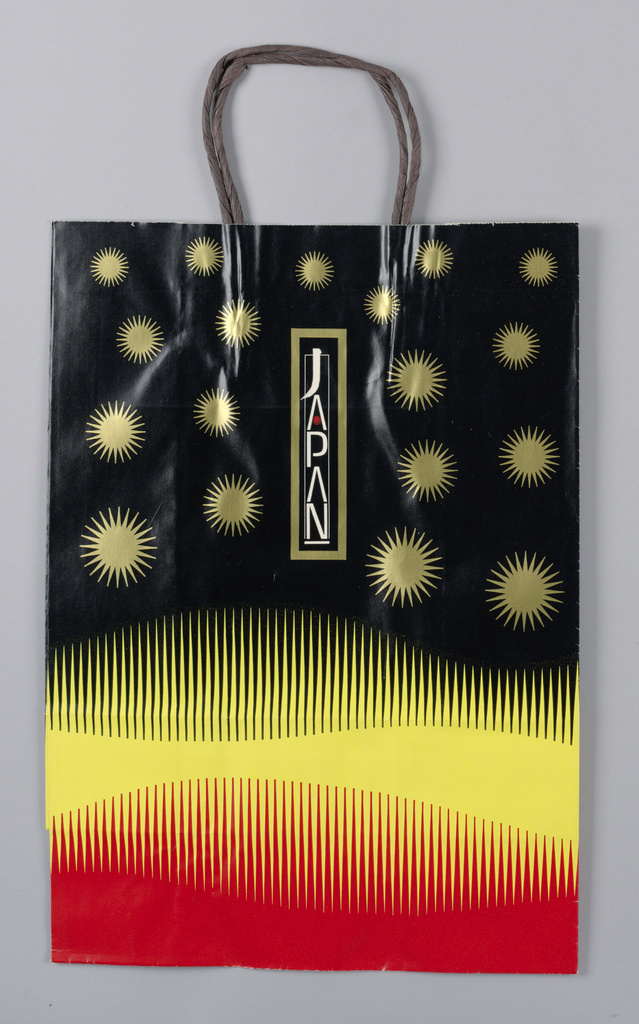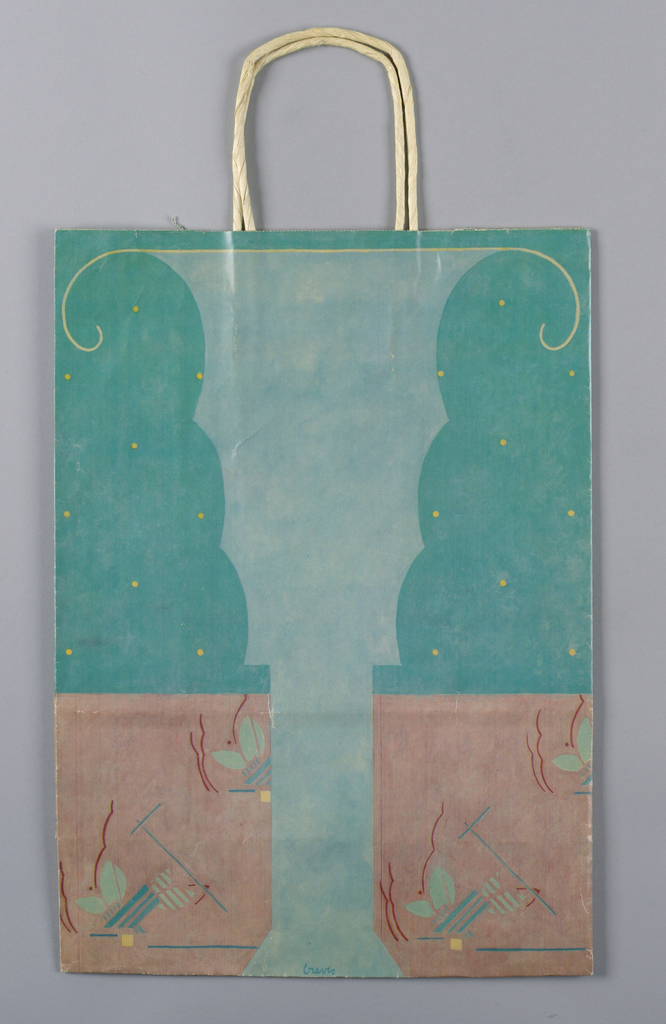Buy something at Bloomingdale’s, and you’ll likely receive one of three different brown paper bags: little, medium or big, depending on the size of your purchase. Spelled out in iconic sans-serif, these size classifications are the classic bags’ only adornment. This striking, simple design, created by Massimo Vignelli in 1973, has seen huge success as an advertising campaign, and even inspired popular spinoff products .The “big brown bag” was the first generation of the series, produced in order to accommodate large household products such as linen and pillows. In response to its instant popularity, little and medium bags followed to complete Bloomingdale’s brown bag trinity.[1] However, the history of Bloomingdale’s paper bag started much earlier. In fact, Bloomingdale’s is a pioneer of shopping bag culture in America.

The first Bloomingdale’s shopping bag appeared in 1922 . It bore an anniversary message thanking loyal customers. Executives quickly realized the promotional potential of these bags, and used them to develop a new marketing model.[2] Bloomingdale’s has since produced a variety of paper bags, which have been serving shoppers and brightening New York streets for generations. The bags produced between 1979 and 1993 are especially notable in the store’s history. During this period, the store turned paper bags into canvases, and commissioned popular designers and artists to experiment with them. “I wanted each bag to be a statement of the times,” then creative director John Jay said in an interview with the Smithsonian.[3]
The bag above, illustrated by Anthony Russo in 1986, is a great example that embodies the energy of New York City. Viewed through the spikes of the Statue of Liberty’s crown, iconic skyscrapers reach toward a sky alight with fireworks. The bag’s dynamic composition and invigorating pink and yellow palette create a festive mood.
Natalie du Pasquier and Christoph Radl, of the Italian design group Memphis, combined contradictory images—traditional architectural drawings and playful toy-like graphics—to demonstrate postmodernist aesthetics on their paper bag from 1984.

Shopping Bag, Bloomingdale’s: Ecco l’Italia, 1984; Designed by Natalie Du Pasquier and Christoph Radl; USA; paper with pink plastic handles; 53.7 x 30.5 cm (21 1/8 in. x 12 in.); Gift of Suzanne Sekey; 1992-77-8
The Japanese graphic designer Kazumasa Nagai designed a more traditional bag in 1985. Its coloring evokes black lacquerware with gold adornment. Yellow lines spreading across a red field create an ambient glow. The scene is reminiscent of a rising sun—a symbol of Japan, tied to the etymology of the country’s name.

Shopping Bag, Bloomingdale’s: Japan, 1985; Designed by Kazumasa Nagai (Japanese, b. 1929); clay coated paper with twisted paper handles; 42.5 x 30.5 cm (16 3/4 x 12 in. ); Gift of Richard A. Manetta; 1992-141-28
The American architect and product designer Michael Graves created an illusionistic design for his Bloomingdale’s bag. One viewer might find a carved glass in the middle of the bag, while another might only see two potted shrubs side-by-side. This interplay of graphic elements is certainly evocative of semiotic motifs which recur throughout his work.

Shopping Bag, Bloomingdale’s: Michael Graves, 1984; Designed by Michael Graves (American, 1934 – 2015); clay coated paper with twisted paper handle; 41.9 x 30.5 cm (16 1/2 x 12 in. ); Gift of Eric Ettlinger and family in memory of his cherished wife, Lyse; 1993-45-13
Bloomingdale’s bag commissions from the 1980s and early ‘90s not only reflected cutting-edge trends in contemporary design—they also encouraged customers to engage creatively with the store. These portable canvasses turned city streets into a public gallery space, where the art of shopping was celebrated.
Sakura Nomiyama is a student in the M.A program in the History of Design and Curatorial Studies program offered jointly offered by the Parsons School of Design and the Cooper Hewitt, Smithsonian Design Museum. She is a curatorial intern in the Drawings, Prints & Graphic Design Department of the Museum.
[1] “The Most Famous Shopping Bags in the World,” Bloomingdale’s, accessed February 22. http://www1.bloomingdales.com/about/company/press/detail.ognc?newsID=71
[2] Ibid.
[3] Owen Edwards, “Sacks Appeal,” Smithsonian Magazine, December 2006, accessed February 22. http://www.smithsonianmag.com/arts-culture/sacks-appeal-139488044/?no-ist

3 thoughts on “The Art of Shopping”
Alex Lindsay on November 1, 2018 at 12:02 pm
Our Conpamy, Modern Arts has an extensive
collection of historical paper shopping bags.
I would like to know who to contact to
explore mutual benefits.
TamaquaMargot on April 5, 2022 at 8:04 am
I have many of the BloomingDales shopping bags I have collected in most occasions in excellent conditions and would like to share the ones I have and also view other collections of BLOOMINGDALES bags I do not have. They have always fascinating the most of the art in each one that I have seen. But my interest in knowing more about BLOOMINGDALES Artists in theses bags is something I would love to explore
Amy Poland on January 1, 2023 at 1:17 pm
My father’s company Poland Brothers Imperial Packaging served many retailers in the 50’s, 60’s & 70’s with branded shopping bags, coordinating papers. He worked with Peter Max pretty early in his career the art department was fabulous& thanks to my mother’s flair & style~ Iris was unforgettable
So many innovations & patents. The first drawstring poly bags from his factory in Taiwan. Remember the machines at the end of the escalators in almost any store in the country? Buy a gorgeous, branded shopping bag for a quarter… that was my dad Sidney Poland. My appreciation of the shopping bag has made me a collector, mostly from perfume launches & beauty, my love & career for 35 years thanks